-
REMAINDER (Omer Fast 2015)
OMER FAST: REMAINDER (2015)
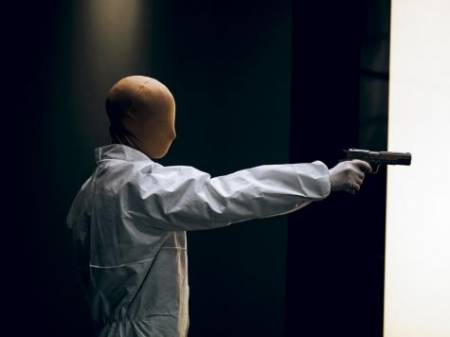
An adaptation of Tom McCarthy's cult debut novel by a prolific Israeli video artist; his first feature
As Rudge says in Alan Bennett's The History Boys, "History is just one fuckin' thing after another," and life as seen in Tom McCarthy's 2006 novel Remainder, handsomely condensed in Israeli video artist Omer Faast's feature, is but a concatenation of events, which the protagonist, Tom (Tom Sturridge), is at pains to reconstruct. He has been smashed down on a London street by falling debris, and, after a period in hospital, struggling back to life, finds himself robbed of much of his memory. This includes his early life, and what he was doing on that street.
As Catherine Bray wrote in Variety at the film's October 2015 London debut, Remainder is above all "a beguilement of memory like its predecessors Memento and Mulholland Drive." But it's also a detective story, a "sporadically playful psychological thriller," and an obsessive thriller. Because it's so condensed, McCarhy's story is (as Bray says) "harder to follow for the uninitiated" than the book. With his alabaster skin and bee-sting lips, Sturridge has a face the camera loves. Tom's recovery time is illustrated with many shaky extreme closeups. Fast lets one enjoy simply contemplating the actor's languid impersonation of the lead and the video artist's slick recreation of Tom's explorations of memory and events, a few of which are constantly revisited. In the increasingly obsessive varied versions, scenes from Tom's present and past, a sense of urgency and dirty business arises.
We can't reveal all but there's this. When Tom comes to, heavily bearded, he can't remember anything after the thing falling on him, and not much before. Of the traumatic event anyway he is not supposed to speak, a condition of the £8.5 million settlement a lawyer has arranged for him. He's been in a coma for months, and has to relearn how to move, and take constant pills for pain and to sleep. But a crack seen at a party reawakens memories of his youth, and he starts reconstructing events, using his new wealth and a hired fixer, a tidy, bearded, bespectacled man called Naz (Arsher Ali), sort of like a film director, to do it. He stages a house, several houses, keeps hired actors on call, a woman frying liver, cats on a roof, a whole string of people and things. And all along, people Tom finds who may have a sinister significance. Perhaps the ending, involving protracted reenactments of a robbery, is too much like a thriller. But it is thrilling. Perhaps in this form, we may have too much trouble connecting the dots. We're obviously not meant to always separate real from dreamed, even know if any of this is happening; it's still fun. I haven't read the novel -- yet. But this is material for re-watching and discussion.
Remainder, 97 mins., debuted Oct. 2015 at London, where it was filmed; also at Berlin Feb. 2016. Screened for this review as part of New Directors/New Films (FSLC/MoMA), Mar. 2016.
Last edited by Chris Knipp; 03-01-2016 at 08:39 PM.
-
KILL ME PLEASE/MATA-ME POR FAVOR (Anita Rocha da Silveira 2015)
ANITA ROCHA DA SILVEIRA: KILL ME PLEASE/MATA-ME POR FAVOR (2015)
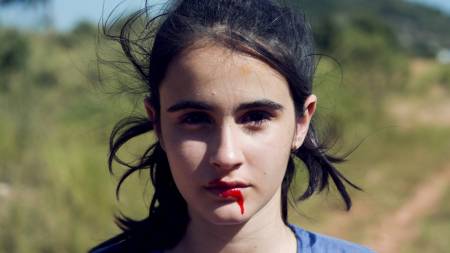
VALENTINA HERSZAGE IN KILL ME PLEASE
Vile, beautiful girls make out and dream of death in a posh soulless suburb of Rio
Anita Rocha da Silveira’s bright-colored debut feature wallows adoringly among pretty young Brazilian girls, and a few pretty young Brazilian boys. it is not a "slasher flick," and there is no "teenage angst." There is a lot of kissing, and some dancing, and a background of murders of young women in the wasteland surrounding large new suburban housing estates in Rio de Janeiro’s Barra da Tijuca. The girls, who belong to a competitive clan, are morbidly fascinated with the idea of being murdered, presumably after being raped, by a man. Particularly the pale, pretty, faintly ghoulish Bia (Valentina Herszage).
Bia wants to have sex with her boyfriend, the cute, sweet Pedro, but he follows a Christian agenda. One of the films' more successful outrages are scenes of a heavily made up young female "priest" who delivers trendy sermons and hip Christian songs to a small young audience including Bia and Pedro.
Filmmaker Anita Rocha da Silveira delivers on the exhibitionistic formal eye candy in every scene, with quite a succession of pretty young people. What she cannot seem to deliver on is story. Possible nods to to Brian De Palma’s Carrie, Jacques Tourneur’s Cat People, and the atmospheres of David Lynch cannot make up for the fact that there is no narrative structure to speak of. Kill Me Please is more like a music video than a feature film. In his Hollywood Reporter review, Jonathan Holland says the film "packages its horrors too neatly into beautiful images."
Kill Me Please/Mata me por favor 101 mins., in Portuguese, debuted in the Orizzonti section at Venice Sept. 2015, and went on to win prizes at Rio, with three other festivals including Gothenburg and New Directors/New Films in New York. Watched at the latter for this review Mar. 2016.
Last edited by Chris Knipp; 03-03-2016 at 07:53 AM.
-
LIFE AFTER LIFE/ZHI FAN YE MAO (Zhang Hanyi 2016)
ZHANG HANYI: LIFE AFTER LIFE/ZHI FAN YE MAO (2016)
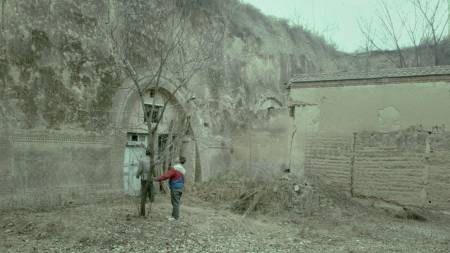
ZHANG MINGJUN AND ZHANG LI IN LIFE AFTER LIFE
A returning soul visits a ravaged land
In the story, which is pursued with quiet obsessiveness, a youth, Leilei (Zhang Li), becomes possessed by his late mother, Xiuying, whose spirit has wandered the Shanxi Province’s disintegrating cave homes for years. With the help of Leilei’s father Ming Chun (Zhang Mingjun), whose reception of his late wife’s return is deadpan (Buster Keaton has nothing on these two guys), they undertake the Sisyphean process, to please Xiuying, of moving a tree from her family's courtyard higher up in the desolate dust-covered mountains that surround them. Panoramic shots show a valley spanned by modern mining apparatus, while up close beyond the man and possessed boy plod around a depressing, desolate village where nobody is friendly, not even their relatives.
The film was reviewed at the Berlinale by Clarence Tsui in Hollywood Reporter. It was produced by Jia Zhang-ke, whose deadpan sarcasm Tsui detects in this film; she also sees links with Kafka, Camus, and the camera style of Pedro Costa. The festival blurb sees a link with "the gentle supernaturalism of Apichatpong Weerasethakul." Actually, this is a very Chinese film, and is suffused with the spirit and style of Jia.
The sad, fatalistic mood of Life After Life made me think of Arthur Waley's translation of the old Chinese poem The Chrysanthemums in the Eastern Garden: "With what thoughts of sadness and loneliness/I walk again in this cold, deserted place!/In the midst of the garden long I stand alone;/The sunshine, faint; the wind and dew chill/The autumn lettuce is tangled and turned to seed;/The fair trees are blighted and withered away." And so on. But in Zhang Hanyi's film, nothing blooms. It is probable that Zhang means the moving of the leafless tree as a gesture toward the destroyed earth of modern China.
There aren't any closeups other than the staring face of Leilei/Xiuying facing backward as they forge ahead on his father's curious vehicle, in which a small pickup truck appears to have mated with a motorcycle. The task of getting the tree into this contraption is truly Sisyphean: following a method they've seen applied to a very large rock, they work the tree onto the truck along a long plank. Leilei pulls a rope lassoed around the bulky bottom of the tree wherein its roots are wrapped, while his dad, holding its thin trunk, rocks it side to side. Up a plank they go, but just before entering the truck, it falls down, do they must work it all the way back to the beginning of the plank, to start anew.
People encountered in the village are sullen and unattractive. Xiuying's family are not welcoming, but don't expel the pair from a grim outdoor meal.
Looking for Xiuying's father's spirit, they believe they've found it in an unruly, highly sexed dog. The New Directors series of which this was a part has included more than its share of animals slaughtered onscreen. This one can boast the most morbid and prolonged animal execution, which we're forced to watch all of. It involves strangling a sheep held to the ground. It takes an age for the sheep to die.
When the task is done, as promised Xiuying leaves, and Leili's body goes limp. We see Ming Chun carrying it on his back -- another Sisyphean task? -- and calling to Leilei's spirit to return. But it does not return.
While we are making sophisticated western references, we might mention Beckett. The meaning of the film's title in Chinese is "labyrinthine branches with plentiful of leaves," obviously deeply ironic as applied to the scrawny tree that's moved. It's a tree off the set of Waiting for Godot, and the words recall Clov's when he looks toward the audience and Hamm asks him to report and he says, "I see a multitude in transports of joy."
Life After Life/Zhi fan ye mao, 80 min., debuted at Berlin's Forum section Feb. 2016. It's listed on IMDb as being "in development." Screened for this review as part of New Directors/New Films (FSLC/MoMA), New York, Mar. 2016.
Last edited by Chris Knipp; 03-03-2016 at 07:38 AM.
-
THE FITS (Anna Rose Holmer 2015)
ANNA ROSE HOLMER: THE FITS (2015)

ROYALTY HIGHTOWER IN THE FITS
Black girls at a rec center in Cincinnati; a girl torn between two worlds
In this engaging but frustrating debut feature -- another one in 2016 New Directors (like the Brazilian Kill Me Please) that's more like an extended short than a feature -- tomboyish 11-year-old Toni (Royalty Hightower) moves from boxer training, which she shares with her older brother, to a dance-marching band group across the way that is all girls. And some of these girls start having epileptic-like fits, which are initially attributed to the water -- a timely reference in view of the recent scandal about the water supply of Flint, Michigan.
Holmer blends scenes back and forth between Toni and her brother at the boxing gym, the dance workouts, a couple older boys and girlfriends, the fits, an empty swimming pool, and walks home with Toni and her brother. There is a lot of well-filmed physical activity, especially exercises like pull-ups and sit-ups, repetitious dance routines (standing in place, body and arm movement, not leg), and byplay between Toni and her brother. The best things are the warm and playful interactions between Toni and her brother. They play so naturally together. Royalty Hightower is a poised, versatile charmer.
Though she's presented as a tomboy, Toni's ear-piercing and nail-painting moments show she's not un-feminine; but she is simply a little detached from the others at times.
In a Variety review from Sundance Nick Schrager describes this film as "An abstract portrait of adolescent emotional dynamics," and says Holmer "crafts a meticulous mood of psychological isolation and beguiling mystery through her metaphorical tale, which exhibits less interest in traditional dramatic conventions than in situating viewers in its protagonist’s particular headspace." This is accurate in the way it suggests The Fits is more like an art piece, or at moments a music video, than a conventional feature film, but it's not so clear how Toni's "headspace" is being simulated, since that's all wordless and inarticulate. Suppose she had had a voiceover or a diary? Clearly Toni and her brother live in the projects. But the camera never follows them all the way home. And though Holmer conveys a vivid sense of the youth community at the rec center, the other characters are visited only fleetingly. There is a lot of staccato, natural dialogue. But it doesn't gain much narrative purchase.
Schrader explains that the film was developed through a "micro-budget program at the Venice Biennale institute that stipulates all projects be completed in under a year." It does indeed show promise, for its vividness and energy. But Holmer needs to work more on story and delve deeper into her characters.
The Fits, 72 mins., debuted at Venice, and showed also at Sundance and New Directors/New Films, where it was screened for this review. Picked up for US distribution by Oscilloscope. Opens in Theaters on June 3rd 2016. (Well received: Metacritic rating 77%.)
Last edited by Chris Knipp; 06-03-2016 at 01:03 PM.
-
SHORT STAY (Ted Fendt, 2015)
TED FENDT: SHORT STAY (2015)
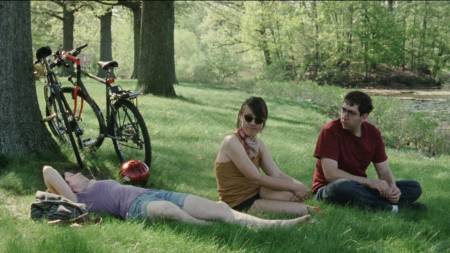
MIKE MACCHERONE (RIGHT) IN SHORT STAY
Mumblecore schlub's abortive summer sojourn in Philly
Mike MacCherone is a towering nerdy guy, and he gives phatic nerd utterance an almost epic level of inexpressiveness.
According to the festival blurb, in Short Stay the director, Ted Fendt, "delivers on the promise of his acclaimed short films without sacrificing an ounce of his singular charm and rigor." Really? The "singular charm" is a bit hard to perceive. Whose? Certainly not the protagonist's; he has none. Short Stay reads like a rudimentary "mumblecore" film, with no progress beyond the minimalist genre's early days -- depicting, as the first halting examples of the genre often did, the unremarkable everyday doings of an unappealing thirty-something going nowhere very slowly. Mike (Mike MacCherone, who presents as height and bulk almost without personality), whose job delivering pizzas has few career opportunities, is offered a chance to sublet a friend's room in Philadelphia. He also gets to do the guy's city walking tours.
The blurb author says the film shows "economy of expression." That's easy: not much is happening: a few parties, a few uneventful dates, the room, the job. And also, we're told, Fendt has an "incomparable nose for the tragicomic dimension of the everyday." Actually, the events are drab and ordinary. They are neither tragic nor comic.
And then there are the tech aspects of the film, its nonexistent artistry. The images are 16mm blown up to 35mm, but a very far cry from the gorgeous look such formatting can have as exemplified by the Oscar-nominated work of Edward Lachman for Todd Haynes'd Carol last year. This looks like a movie shot in home video, but it isn't ironic or period, as in mumble "godfather" Andrew Bujalski's strange, fascinating Computer Chess. While Lachman has shot on super 16 for "grain," a rich human texture, in Short Stay the images just look rudimentary and blurry. There is no visual sense here. The shooting gets us through the scenes, just barely, and that's it. The déjeuner sur l'herbe still (shown above) is a rarity. Most shots are medium closeups you might see in a telenovela.
As for Fendt's moving up from shorts without loss, the problem is that he has only barely moved up. Short Stay, with its repetitious incidents and scenes, reads simply a short film in need of editing. It makes 61 minutes seem like a long time. It is a bore. However, Fendt may grow, as a few "mumblecore" directors (notably Bujalski) and actors (notably Greta Gerwig) have done. Miracles can happen. But this audition isn't very promising.
Short Stay, 61 mins., debuted at the Berlinale 12 Feb. 2016. It shows again 20 Feb. as part of New Directors/New Films in New York, where it was screened for this review.
Reviewed in Hollywood Reporter at the Berlinale by Jordon Mintzer. It debuted in the Forum section there. Shot in 16mm. and blown up to 35 mm. film. The director and his project are sympathetically described by Caroline Marques in an article for the Philadelphia Inquirer.
Last edited by Chris Knipp; 03-03-2016 at 08:00 PM.
-
KAILI BLUES/LU BIAN YE CAN (Bi Gan 2015)
BI GAN: KAILI BLUES/LU BIAN YE CAN (2015)

A dreamy Chinese road picture that's a visual tour-de-force -- and an impressive debut
Chen Sheng (Chen Yongzhong), the protagonist of Bi Gan's complex and breathtakingly enthusiastic exploration of cinematic possibility, has for some time now been a country doctor, working in a small clinic with an an older woman doctor, Guang Lian (Zhao Daqing), in the subtropical province of Guizhou. In time through hints and finally his own crabwise confession in a barber shop, we learn that he previously spent nine years in prison, taking the rap for others. In the long dreamy sequence that makes up most of the latter part of the film Chen is on the road, initially at least in search of his nephew, Weiwei. He has believed that his gangster half brother, Weiwei's cruel father Crazy Face (Xie Lixun), had sold the boy. There are other differences with Crazy Face -- over inheritance of a house, and his mother's tombstone. On his trip Chen hopes not only to visit Weiwei but a former gangster associate known as Monk who now runs a watch shop and an old friend of Guang Lian's she's been dreaming of lately and wants to send a gift to; she says she's too old to travel.
So this is a road picture, one with elaborate motives and back stories, concepts and commentary with built-in homages to great Chinese filmmakers of the previous generations. But it's also simply a demonstration of the joy of filmmaking. From the outset Bi Gan shows a passionate awareness of the aesthetic possibilities of his rural Chinese milieu, of everything the eye of the camera encounters. The lens of his cinematographer Wang Tianxing, remarkably debuting here, seems to gobble up the diverse scenes, whether they be a sweeping verdant hill landscape, a jumble of rundown buildings and debris, a mobile crane performing a nimble maneuver off a truck, a bunch of motorcycles mounted by young men acting as rudimentary cabbies, or young toughs -- in classic scenes right out of iconic Hou Hsiau-hsien films -- hanging out, striking poses, and playing pool. Whether the material filmed is superficially "ugly" or "beautiful" or simply drab, it's arranged on screen in ways that show a sure eye and a keen sense of composition. But the scene is what matters, not some arbitrary arrangement.
And then, along Chen's journey by train, bus, truck, and motorcycle, the camera takes flight, following people around and weaving in and out the hillside town for a 40-minute unbroken long take in the virtuoso tour-de-force manner of Aleksandr Sokurov's Russian Ark, but focused not on period costumes and museum art works but humid landscape, scruffy men, pretty women, roads, motorcycles, interiors with decaying walls.
The search, which is also a memorial journey, taking Chen to the riverside city of Kaili and town of Dang Mai, has seemed primarily motivated by concern for the well-being of Weiwei (Luo Fengyang as a youth, Yu Shixue older), whom he meets magically by chance. But voiceovers of poetry, the mesmerizing camera movements, begin to suspend us in a magical present time, like a drug high, where plans and goals are suspended and nothing matters but everything is hyperreal. We are there. China, this awesome, terrifying, destroyed and destroying country, seems magical again. One is brought back to the early films of Wong Kar-wai, Hou, and Jia Zhang-ke. (Others have seen a link with the Thai Cannes darling and explorer of magic and ghosts, Apichatpong Weerasethakul, but that seems more of a stretch. The director, barely thirty, has mentioned Andrei Tarkovski as an influence.
Reviewed by Derek Elley for Film Business Asia in his typical meticulous but not infrequently grumpy manner, Kaili Blues doesn't fare so well. Obviously, more is going on than we can possibly gather in one or even many viewings, and we need a guide. Elley helpfully points out that the Chinese title means "Roadside Picnic," and is the name of the main character's anthology of poems. Elley grants that the filming is a tour-de-force: "In sheer planning — as the camera follows the doctor on a motorbike, up and down stairs, into people's homes, on a river ferry, and across a bridge — it's a considerable achievement, with hardly a glitch." But Elly is unmoved. He doesn't see this as a meaningful explication of the narrative or character, or as having the mystical quality that is desired, as suggested by the voiceover "foggy poems" (as he condescendingly calls them) attributed to the main character (and actually by Bi Gan, who is a published poet).
But I was thrilled, and found the latter sequences of Kaili Blues made me feel high -- high on this exotic world, on the joy of filmmaking and film-watching. I remembered the excitement when a tip in the San Francisco paper led me to a hitherto unknown movie house in Chinatown (or so I remember it) and I saw the first two films of Wong Kar-wai. I didn't make much sense of them then. But I had entered a new world, and was hooked. What Elly calls "a conventional Mainland indie" is dense with ethnographic detail (indlucing visits to the Miau people from whom Bi Gan comes, the locations being his native region), a Diamond Sutra epigraph, intricate motives and backstories (with possibilities for future development) and it's not at all out of place for John DeFore to say in his Hollywood Reporter review that Kaili Blues "invites academic thesis-level dissection." But he is also right to add -- we feel the freshness of the energy and enthusiasm -- that "thanks in part to Chen's unforced performance, it never feels pretentious." Whoever wrote in the ND/NF blub calling this "one of the most audacious and innovative debuts of recent years" was certainly on the right track (despite a surprising lack of buzz since Locarno). There could be a glorious future here.
Kaili Blues/Lu bian ye can/ 路邊野餐, 113 mins. debuted at Locarno, where it won Best Emerging Director and Special Mention awards.It also won the Montgolfière d'or award at the Nantes Festival of the Three Continents and also has been in the Vancouver festival, where one blogger noted technical flaws in the long hillside take camerawork. Shelly Kraicer provides loving details in a piece reprinted in Cinemascope. It has been hailed by French critics ("of an unheard of virtuosity," Liberation; "a splendor," Les Inrocks) and it's coming out in France 23 March. Screened for this review as part of the 2016 Film Society of Lincoln Center-Museum of Modern Art series New Director/New Films. It will show Mon. 21 Mar. at 6:30 p.m. at MoMA and Wed. 23 Mar. at 6 p.m. at the Walter Reade Theater, Lincoln Center.
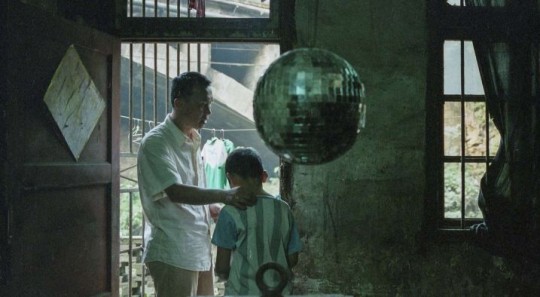

Last edited by Chris Knipp; 03-05-2016 at 05:42 PM.
-
Shorts program 2
SHORTS PROGRAM 2

THE DIGGER
Shorts Program Two
The Digger
Ali Cherri, Lebanon/France/UAE, 2015, 24m
Arabic and Pashto with English subtitles
With ritualistic serenity, a lone caretaker maintains ancient graves in the Sharjah Desert long after the bodies are gone. North American Premiere
This is a beautiful, dignified visual poem, with no voiceover. The only text is printed literary Arabic. It's probably the best and most memorable of the program, but what can you say about it?
We All Love the Seashore / Tout le Monde Aime le Bord de la Mer
Keina Espiñeira, Spain, 2016, 16m
French and Pulaar with English subtitles
A poetic distillation of the liminal space of refugees and migrants, developed collaboratively through encounters on the African coast of the Mediterranean. North American Premiere
"Poetic distillation" means that while actual refugees are used, this like the rest is an art piece. The are highly scripted, arranged, and poeticized. Which given the global refugee crisis at present seems a bit out of touch with reality.
Of a Few Days
Timothy Fryett, USA, 2016, 14m
On the South Side of Chicago, final touches on one’s
journey on Earth are meticulously made in a decades-old community funeral home. North American Premiere
A close look at a few details of how a funeral home is run and the preparing of the dead. Not really quite a documentary though, because like the other films here, it is highly selective.
The Park / Le Park
Randa Maroufi, France, 2015, 14m
French and Arabic with English subtitles
A series of tableaux vivants mesmerizingly locate the intersection of public space, inner lives, and social media within an abandoned Casablanca amusement park. U.S. Premiere
The strangest and most interesting short in this set because I haven't seen anything like it before. Very suggestive. But I had no idea what this was about, and I'm not sure if we're expected to know. There may be some reference to recent crimes or gang battles or something. The "dialogue" in French and/or Moroccan Arabic is fragmentary, and comes and goes before you can make it out. The "tableaux vivants" are really that. Groups of nice looking young people, mostly men, are frozen in place, some with knives raised as if about to strike, though they have pleasant expressions. The camera moves around among them. They really don't move. At most one guy's eye moves. But what could it possibly mean? A good art piece to show in a museum. No feature film potential imaginable. Hence the New Directors jury in this section have chosen to marginalize the festival.
Last edited by Chris Knipp; 03-03-2016 at 07:55 PM.
 Posting Permissions
Posting Permissions
- You may not post new threads
- You may not post replies
- You may not post attachments
- You may not edit your posts
-
Forum Rules





 Reply With Quote
Reply With Quote








Bookmarks